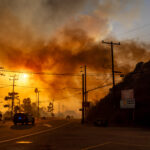Those in the insurance industry tend to view everything through a lens of risk and responsibility. Sure, that game/sport/amusement/party looks like a good time, but what horrible thing could happen? And who is going to pay for it when it does?
Especially when that fun is hanging out in a room full of flying axes. Or speeding down a busy, bumpy sidewalk on a tiny scooter. Or jamming a dozen kids into a bounce house to ricochet off each other like Jiffy-Pop.
In some cases, businesses and organizations seek out special coverage to keep users and clients safe. In other instances, a person may want to re-read their homeowners policy and health insurance before jumping into the fray.
Shared Electric Scooters
In many cities across the U.S., electric scooters are lined up along the street, or randomly abandoned on sidewalks, ready for rental.
Easy access suggests safety. But while shared electric scooters offer convenience and a little fun, they can also pitch a rider face-first into a pile of medical expenses.
Greg Reigler, a photographer now living in Atlanta, Ga., hopped on a scooter one night for a quick, mile-long ride home on familiar streets in Pensacola, Fla. Unfortunately, an unnavigable curb caught his front wheel and sent him flying, resulting in medical and dental injuries totaling nearly $40,000. Reigler was without health insurance, and with no other party to step up for his medical bills, he was on the hook.
“Upon renting the scooter, you agree to the terms and basically sign away liability,” he said. Reigler didn’t file a police report, which precluded him from pursuing compensation from the scooter company or the city. “I was mainly worried about getting to a hospital.”
The scooters can reach speeds exceeding 15-20 mph, and generally renters are not required to have a driver’s license. Each state has different rules and regulations regarding electric scooters, but in most cases, electric scooter companies typically won’t cover injuries resulting from an accident.
A 2019 study published in JAMA monitored two Southern California emergency departments that saw 249 patients with electric scooter-related injuries over the course of a year, mostly suffering from fractures, head injuries and soft tissue injuries; 228 (91.6 percent) were injured as riders and 21 (8.4 percent) as nonriders. About 11 percent of patients were under 18, and only 4.4 percent were wearing a helmet. The study’s sample showed riders had little regard for age or helmet requirements.
The rapid growth of shared electric scooter use has not given communities time to address issues such as traffic safety regulations and the impact on pedestrians and other bystanders.
“We’ve seen some municipalities promote electric scooter programs as a way to clear congestion in downtown business areas, with some of them later backing off from that when they realize the hazards that are involved,” said Joseph S. Harrington, an independent business researcher, in the Insurance Journal Academy of Insurance course “Many Vehicles, Many Uses.”
According to the Insurance Information Institute, standard homeowners policies, renters insurance, personal auto policy and even motorcycle coverage often exclude liability coverage of shared electric scooters incidents. Health insurance may cover injury from an accident, and some personal umbrella policies may provide some protection.
While electric scooter insurance is not required, those who use them for daily commutes or weekend fun may want to look into coverage for any scooter-related injuries or damages. And wear a helmet.
Jump Around – Inflatables
Once relegated to fairgrounds and festivals, jump houses and other giant inflatables such as waterslides and obstacle courses have become common fixtures at home birthday parties and other family events.
However, in the age of viral videos, wind-borne bounce houses and other inflatable risks have become more visible. A 2022 study from the American Meteorological Society documented 132 wind-related bounce house incidents worldwide between 2000 and 2022, resulting in 479 injuries and at least 28 deaths. At the time of the study, 17 states had no regulations or expressly excluded inflatables from regulation. However, 19 states explicitly cite American Society for Testing and Materials standards specifying wind speed limitations and may require the presence of a meteorologically astute attendant for commercial bounce houses.
The National Electronic Injury Surveillance System (NEISS) estimated 159,569 bounce house injuries in people under 18, with a linear increase from 2000 to 2019. A reported 82,748 kids were injured between 2015 and 2019, compared to only 5,599 from 2000 to 2004. In 95 percent of all cases, the injuries occurred at the patient’s home.
Bounce house manufacturer and wholesaler eInflatables offers insurance advice and recommends that retailers and rental companies have liability insurance, workers compensation and property insurance. Liability coverage is often required to rent to venues such as parks, schools and other public events. The site suggests retailers go through an inflatable insurance broker, who will then go through an underwriter to get a customized policy. Requirements can vary, but a $1 million minimum policy limit is typical.
Axe and Smash
While the first generation of “extreme sports” is still out there dislocating shoulders and breaking legs, there’s a new adrenaline rush in town. Axe throwing and smash rooms, or rage rooms, have become some of the country’s fastest-growing attractions. Both are popular group activities and are even popular outings for corporate team building.
Yet, despite what would be seemingly obvious danger, axe throwing and plate smashing are made safer with regulations and watchful ownership. And, of course, most places are going to have customers sign waivers that explain the rules and limit the company’s liability.
“Most axe-throwing venues are operating under the rules and regulations set by the World Axe Throwing League, including strict safety protocols,” said Brett Pollak, president of Insurance Allies, a Chicago-based agency that specializes in the entertainment industry and hosts the sites AxeThrowingInsurance.com, SmashRoomInsurance.com, HauntedHouseInsurance.com, as well as PickleballInsurance.com.
There are more than 600 recreational axe-throwing venues across the country up from just a few dozen five years ago.
“These venues don’t need too much coverage above and beyond what you would see in any other entertainment venue,” Pollak explained. “It’s about structuring the policy to cover the things that matter to a venue owner, such as, but not limited to, BYOB, or the sale of alcohol, the weapons allowed, etc.”
Most, if not all, insurance coverage for the axe-throwing industry is non-admitted and every policy/contract is different. Venue owners need to be informed of coverage and exclusions presented in the contracts.
Axe-throwing and smash room businesses need general liability, which may be either occurrence or claims-made general liability insurance policies. Axe-throwing businesses may also need umbrella, accident insurance, property insurance, workers comp and liquor liability.
For smash rooms, which typically let clients go wild on breakables and furniture, Pollak’s smash room insurance site recommends general liability, accident insurance, property insurance, liquor liability insurance and coverages customized to a client’s needs.
“Safety gear, including full suits and goggles, help protect the participants from flying debris,” Pollak said.
One of the biggest risks is over-exuberant clients accidentally hitting other people in the room, so the number of people per room is limited.
While office equipment is a popular smash room request, the chemicals and other dangerous components in computers, TVs and other electronics have pushed many establishments to pull decommissioned printers and old fax machines from the menu of destruction. They want clients to smash responsibly.
“Business owners are very aware of their business, the risks involved and how to mitigate those risks,” he said. “They strive first and foremost to protect their customers and, in turn, this helps set their business up for long term success by preventing lawsuits.
“In addition to educating venue owners, as an insurance agency we strive to vet prospects and clients, which protects people, and in turn this helps to increase the long-term viability of coverage and price of insurance for the industry as a whole.”
Golf Carts
Many golf cart owners treat their cart as a secondary mode of transportation for getting around their neighborhood, whether for running errands or just for fun.
The legalities of where carts can drive, who can drive and what licensing they need vary by area. Most golf carts aren’t classified as cars, but in some cases can be classified as low-speed vehicles, a separate class of transportation. But those laws are tightening in some areas.
Florida recently passed a law that anyone under the age of 18 will need to have a permit or driver’s license to drive a golf cart as of Oct. 1. The need for these types of restrictions were underscored on July 17 when a Florida seven-year-old was tragically struck and killed by a golf cart being driven by a three-year-old.
While municipalities may not require insurance to drive golf carts on public roadways, statistics suggest insurance is a good idea, even if it’s not required.
In 2021, researchers reviewed 2007-2017 data from the NEISS and found an estimated 156,040 people received emergency room treatment for golf cart-related injuries during that period. That same year, a study by the Children’s Hospital of Philadelphia found there are now more than 6,500 golf cart-related injuries in children and adolescents each year, including fractures, dislocations, and head and neck injuries.
Many companies offer some types of golf cart insurance, including many of the same coverages available for other vehicles — liability, collision, comprehensive and even uninsured motorist.
Drones
Recreational drones are the most popular type in the U.S., making up about 63 percent of 855,860 registered drones (536,183) in the U.S. according to DroneSourced.
But with the fun of flying comes great responsibility. Drones can cause injuries and property damage, and not all activity is covered by insurance. According to DroneSourced, there were approximately 4,250 drone injuries from 2015 to 2020, with multi-rotor drones accounting for over 70 percent of reported incidents.
Drones are subject to the same regulatory authorities as other aircraft on federal, state and local levels, said Kevin Amrhein, president of the Florida Insurance School of Continuing Education and the CE partnership, in his Insurance Journal Academy of Insurance course “Drones — Insuring Innovators, Enthusiasts, and Idiots.”
“Liability is the insurance you cannot go without,” Amrhein said. All the ISO (Insurance Services Office Inc.) forms have the same language, and the definition of aircraft liability is very comprehensive.
As drones have become more common, insurance is adapting, so it’s essential to be specific in coverage requests and double-check endorsements for exclusions that apply to model or hobby aircraft.
Personal Watercraft Insurance
As the relatively new adage goes, it’s impossible to be unhappy on a Jet-Ski. And having the right insurance can add an extra layer of joyful security.
Rick Stern, boat product manager at Progressive, said the company covers well over 200,000 personal watercrafts (PWCs), and that number grows every year. While PWC insurance is generally affordable, Stern said, the insurance rate varies depending upon the age, power and value of the PWC and the age, experience and driving record of its operator. Each state has its own insurance requirements, but liability to cover injury and property damage is required in many states and recommended in others.
“Liability coverage will also pay to recover your PWC if it sinks,” Stern said.
Other popular options include comprehensive and collision coverage that will protect PWC from theft, fire, vandalism and collision, and clients also often opt for uninsured boaters and personal effects coverage.
The types of PWC claims have not changed much over the years, Stern said. “One thing we do see is a fair number of PWC-on-PWC claims, since many PWC riders like to go out in pairs.”
There’s a trend toward larger and more powerful PWCs that can seat three people and tow a skier or tube — and the chances of injury increase as the number of participants increases, he added.
In many cases, a little risk is part of having a good time. But if it’s going to rack up hospital, property or legal bills, everyone should make sure they are covered.
*This article was originally published by Insurance Journal, CM’s sister publication





















 Los Angeles Fires Become Existential Test for California’s Stopgap Insurer
Los Angeles Fires Become Existential Test for California’s Stopgap Insurer  California Wildfires Will Likely Lead to Large Economic and Insured Losses
California Wildfires Will Likely Lead to Large Economic and Insured Losses  The Institutes, Kevelighan Fire Back at Retaliation Claims by Former Triple-I Employee
The Institutes, Kevelighan Fire Back at Retaliation Claims by Former Triple-I Employee  Reinsurers in Growth Mode Brought Capacity, Flexibility to 1/1 Renewals
Reinsurers in Growth Mode Brought Capacity, Flexibility to 1/1 Renewals 




